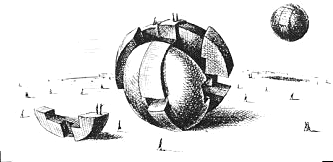« Return to the main page
The subject of our second student-driven discussion will be about
consciousness and how suitcase words like consciousness inhibit
clear understanding. The discussion will take place during lecture next week (6 Mar).
If you are on the discussion panel for next week, you should write out your answers to all of the discussion questions below. You may bring them with you during the discussion, and may write notes on them as well. We'll collect them at the end of class—our grading criterion will be evidence of thoughtfulness and preparation.
If you are in the audience next week, you are also expected to prepare your answers to these questions so that you can participate actively, however you are only required to write out your answer to Question 4. As an audience member, you should submit your response before class via e-mail to society-of-mind@mit.edu.
Assignment 2: Unpacking Consciousness
- A central concept in the Emotion Machine is the idea of a suitcase word— a monolithic word which is used to express so many distinct ideas that it seems impossible to explain, or seems as if it has already been explained—for example, consciousness, awareness, thinking, gestalt, and inadvertently. In order to reach clear understanding, it is important to avoid using such words in explanations and to unpack them whenever you find them.
- Some words contain a large amount of theory—they allow experts to share a large collection of concepts in a succint way. How do words like these relate to suitcase words? (i.e. are they the same? if not, how do they differ from suitcase words?) Should we permit them?
- As of this assignment, we strongly discourage the use of suitcase words in explanations. In particular, you should avoid using them in your response to Question 4.
- In
this TED
Talk video, Dan Dennett challenges the
view that we are all experts on consciousness because we, after all,
directly experience the effects of consciousness.
Watch the video (or if you prefer, read
the corresponding
article).
- Dennett produces a number of visual examples to prove a point about the nature of consciousness. What is the point that Dennett is trying to make? Are you persuaded?
- In contrast with Chalmers (see below), Dennett asserts that all manifestations of consciousness are comprised of tricks; consider the various meanings of the term "consciousness"— to what extent do you agree with Dennett's claim?
- In Facing up to the problem of Consciousness, Chalmers
enumerates the aspects of consciousness that apparently defy explanation. In Chapter 4 of the Emotion Machine, Prof. Minsky endeavors
to explain how they work. Read each account, and critically analyze each
viewpoint — to what extent are the problems that Chalmers discusses relevant?
To what extent does Prof. Minsky adequately address the problems? What
questions do you still have about consciousness? What ideas in each do you want to be explained further?
- In Chapter 4 of The Emotion Machine, Prof. Minsky uses
the example of Joan crossing the street to illustrate how the
how the single word consciousness actually refers
to many different mental processes.
In a short paragraph, develop your own everyday scenario, similar to
the chapter example in duration and complexity. Then analyze your scenario, finding as many different
mental processes taking place as possible. In what ways do these mental processes interact with each other? Is there a feature common to all of them? How do they all contribute to
the collective phenomenon of “consciousness”?
For this problem, and for avoiding suitcase words in the future, you might find it empowering to read Sloman's introduction to conceptual analysis, which is a powerful antidote for suitcase words.


